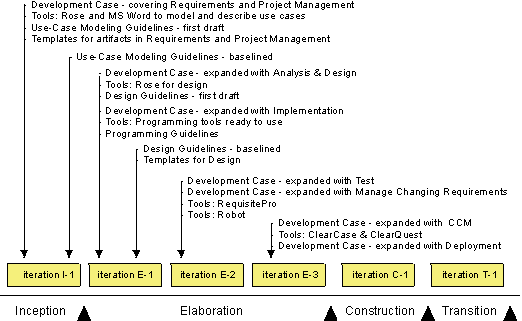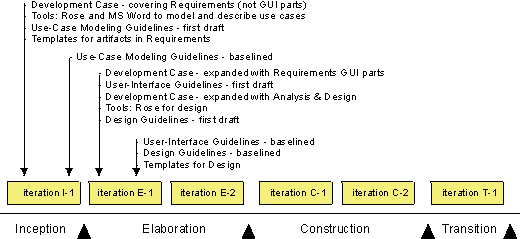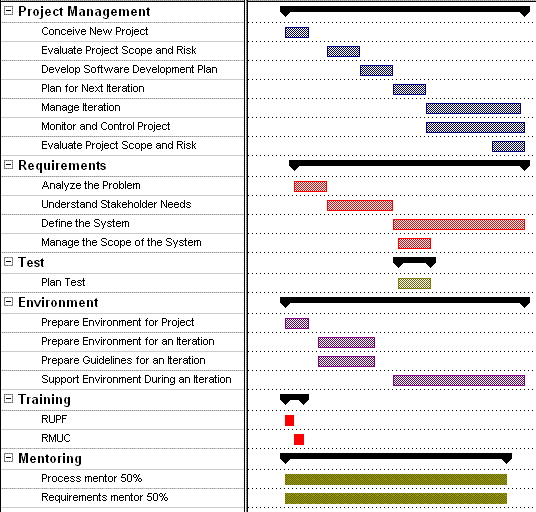Concepts: Implementing a Process in a Project
Topics
This page explains how to implement process and tools in a software
development project by performing the activities described in the Environment discipline. It also
discusses the Project Management discipline, which deals with planning the
project, identifying risks, and managing, monitoring, and evaluating the
project.
It's important to understand that there are different ways to implement
process and tools, as described in the section "Approaches
to Implementing Process and Tools". The approach you choose depends on
the current state of the project and its surrounding organization, therefore, do
an assessment of the project and its surrounding organization. See Activity:
Assess Current Organization.
The page Concepts: Environment Practices gives a
list of proven practices that help you improve process and tools on a
project.
If you want to know more about how to implement process and tools in an organization,
see the page Concepts: Implementing a Process in an
Organization.
These general guidelines apply in almost every project:
- Before the project starts: Before the project actually starts,
people who act as process engineers, tool specialists, and project managers
must be trained in the Rational Unified Process (RUP). This is crucial to
the project's success. If the project members do not know what to do,
they probably will not succeed.
- Inception phase: During this phase, you typically focus on
understanding how to improve the way you manage requirements (Requirements
discipline) and how you manage the project (Project Management
discipline).
- Elaboration phase: By the end of the Elaboration phase, all process
and tools are in place. The most critical part of this phase is often how to
perform configuration and change management because in the Construction
phase, the work is performed by development teams working in parallel.
- Construction phase: No new process or tools are introduced in this
phase. The focus here is to produce the product, therefore the development
environment must be stable. In the Construction phase, the motivation is to
get new people on the project up-to-speed.
- Transition phase: No new process or tools are introduced. In the
Transition phase, the focus shifts from project-specific process improvement
to project post-mortems, gathering project experiences from the current
project, summarizing them, and packaging them in a form that future projects
can use. These gathered experiences serve as input to improving process
and tools for developing of the next evolution of the product.
It's important to understand the basic approaches to
implementing process and tools on a software development project. These
approaches are:
- "Change everything". This means
that the project adopts the entire RUP and a complete
set of new tools.
- "Improve process and tools".
This means that the project decides to improve some areas of the process and
tools by adopting parts of the RUP and supporting
tools.
How much of the RUP to adopt and how many new tools you
decide to implement on a specific project depend on:
- What problems are identified and prioritized for the project
- The capacity for change
These are factors you typically uncover during an assessment,
see Activity: Assess Current Organization,
and capture in Artifact:
Development-Organization Assessment.
A project can decide to adopt the complete RUP and start
to use a new set of tools for one or several of the following reasons:
- There is no process or tools in place and the project needs everything—a
complete process and all tools.
- All, or most, of the people are new hires and no commonly accepted way of
working exists.
- The project will shift to a new technology for the organization, which
means that the existing process and tools will become obsolete.
If you decide to introduce the complete RUP and tools
onto your project, then it's important to incrementally implement the process
and tools. By implementing process and tools in a step-by-step procedure, it's
easier to manage the risks and it makes these changes less overwhelming for the
people on the project. The following diagram illustrates when the different
Environment artifacts would be developed over a project's lifecycle.

The evolution of the Environment artifacts in a project
where "everything is new".
Comments to the plan:
- Overall: The Business Modeling discipline is skipped
altogether.
- Inception: Focus on introducing the Requirements and Project
Management disciplines. To reduce the number of new factors, the
user-interface parts of Requirements are not introduced. The project manager
decides what parts of the Project Management discipline to use.
- Elaboration iteration E-1: Analysis & Design and Architecture
are most important in the Elaboration phase. Automated Test and
Configuration & Change Management are not as crucial this early in the
project because the number of project members is relatively low. This can be
introduced later in the project.
- Elaboration iteration E-2: Test tools and process are introduced to
automate testing. Rational RequisitePro is introduced to manage the changing
requirements.
- Elaboration iteration E-3: In the Construction phase, the work will
be performed by development teams working in parallel. Therefore, it's
crucial to have the Configuration & Change Management discipline in place
at the end of the Elaboration phase. The deployment manager decides how to
perform the discipline in the Deployment discipline.
- Construction: Nothing new is introduced. From an Environment
perspective, the focus during the Construction phase is to get all new
people on the project up-to-speed.
- Transition: Nothing new is introduced. The process and tools are
refined as needed.
The people on a project in an organization where a process and tools are in
place, have the capability to develop a system. These people have a common way
of working, which is a process that may be more, or less, well
documented.
The long-term goal may be to adopt the complete RUP and
a complete set of new tools. However, the short-term goal is to improve on one
or several areas of the process and tool support. These should be areas that
have high improvement potential.
The diagram below shows an example of a project that has decided to adopt the
Requirements discipline along with tools, such as RequisitePro and Rational Rose, to
improve the way requirements are managed. The project has also decided to
introduce the Analysis & Design discipline.

The evolution of the Environment artifacts
when improving Requirements and Analysis & Design.
It's important to understand that the diagram above is only an example. The
parts of the process you decide to improve on will differ between projects,
depending on the problems and needs of a particular project. You must assess the
project and its surrounding organization to find out those parts of the process
you want to improve or which tools you want to introduce.
The following is an example of an iteration in the Inception phase where the
Requirements discipline is introduced. Each entry in the Gantt chart is described
in detail after the diagram.

Example of an iteration in the Inception phase
The basic workflow described in Sample
Iteration Plan: Inception Phase applies with these variations and
extensions.
Project Management
Bring the project from the initial germ of an idea to a point at which a
reasoned decision can be made to continue or abandon it. The main results are
initial drafts of Artifact: Business
Case, Artifact: Software Development
Plan, and Artifact: Risk List.
Identify risks in the project, including those risks associated with
implementing the new process and tools. The result is the Artifact:
Risk List.
Plan the phases. The main result is the section titled Project Plan in the Artifact:
Software-Development Plan. This includes the Phase Plan where you'll find
the major milestones with their achievement criteria, including criteria for
the Environment discipline.
Plan the iteration in detail, including the Environment discipline and all
other disciplines. The main result is an Artifact:
Iteration Plan, with all workflow details and activities of the Environment discipline, as
well as all other process disciplines.
The use of process and tools is appraised as part of the evaluation of the
iteration. The results are:
The project manager monitors the daily work, including the process and
tools.
At the end of the iteration, the risks are re-evaluated, including risks
associated with process and tools. Some risks are mitigated during the
iteration and new risks are identified. The primary result is an updated Artifact:
Risk List.
Requirements
No specific changes.
Test
The test manager defines some logistic aspects of the Artifact:
Master Test Plan that will provide the initial reasoning for the resourcing
the test effort.
The test designer and a small team of testers verify that the key elements
of the Test Approach will work against
the Artifact: Architectural Proof-of-Concept.
and that third-party component selections are verified as being testable.
Environment
Assess the current state of the organization and decide what parts of the
process and those tools on which you want to focus in the first iterations. In
this case the project decided, based on the assessment, to start implementing
process and tools. The results are:
Prepare the process and tools for the Requirements discipline together with
the supporting tools so the people on the project can start using them. (Of
course, other disciplines can be prepared.) Make sure that the people on the
project understand how to use the development case, use-case modeling
guidelines, and tools. In addition to standard training courses, we recommend
that you arrange a one-day workshop where the project members will get
hands-on experience. See Activity:
Launch Development Case and Concepts: Environment
Practices.
The results of performing the workflow detail are:
The result is Artifact: Use-Case
Modeling Guidelines.
The system administrator supports the developer during the iteration.
Training
- All members of the project attend a course that gives
an overview of the RUP in order to get an overview of
the project's lifecycle.
- The people who work on Requirements need to attend a
course where they learn the details of the Requirements discipline in the RUP.
Mentoring
- Process Mentor 50%. Someone who acts as a
process engineer to support the project manager and other people on the
project in using and configuring the process.
- Requirements Mentor 50%. Someone who
facilitates the Requirements work, by leading workshops, reviewing results,
and answering specific questions about requirements.
Copyright
© 1987 - 2001 Rational Software Corporation
|  Disciplines >
Disciplines >
 Environment >
Environment >
 Concepts >
Concepts >
 Implementing a Process in a Project
Implementing a Process in a Project
 Disciplines >
Disciplines >
 Environment >
Environment >
 Concepts >
Concepts >
 Implementing a Process in a Project
Implementing a Process in a Project